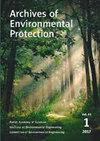反渗透前离子交换分离阴离子的有前途的方法
IF 1.3
4区 环境科学与生态学
Q4 ENVIRONMENTAL SCIENCES
引用次数: 0
摘要
开发了一种提高纯净水质量、降低树脂再生试剂成本和创造低废物工艺的方法。本文介绍了用AV-17-8阴离子交换树脂在NO3形态下进行硫酸盐和硝酸盐离子交换分离的结果。高碱性阴离子交换树脂AV-17-8的阴离子分离效率取决于它们在水中浓度的大小和比例。AV-17-8阴离子交换树脂上的分离已被证明在硫酸盐浓度高达800 mg/dm3和硝酸盐浓度高达100 mg/dm3时是有效的。研究了10% NaNO3阴离子交换树脂再生的条件。对再生液中硫酸盐以硫酸钙的形式进行了试剂沉淀。硫酸钙沉淀物可用于制造建筑材料。再生液适合重复使用。开发的结果将允许引入高矿化度水的低废脱盐技术。[4] I. Trus, M. Gomelya, V. Vorobyova, M. Skiba,这个问题,离子交换分离这些离子的过程在反渗透脱盐之前的阶段可以使用。高度矿化的水中最典型的阴离子是氯化物、硝酸盐和硫酸盐。阴离子交换树脂Amberlite IRA 900的使用允许氯化物和硝酸盐的分离(Berbar, Y. et al. 2008)。如今,反渗透方法是净化氯化物和硫酸盐含量高的水的首选方法(Mubita, T. et al. 2020)。这些阴离子可以在AV-17-8阴离子交换树脂上以cl -形式初步分离。氯化物和硫酸盐在阳极室进行电化学分离时,硫酸被浓缩,氯化物被氧化,然后以氯气的形式释放出来。净化含有硝酸盐和硫酸盐的水要困难得多。值得注意的是,从低矿化水中提取硝酸盐是一项简单的任务(Rajca, M. 2012, Wiśniowska E.和Włodarczyk-Makuła M. 2020)。离子交换是一种相当简单和可靠的方法,可以有效地去除硝酸盐,将其在水中的浓度降低到可接受的水平。离子树脂在钠、钾、铵化合物溶液中再生效果良好。在高浓度的氯化物和硫酸盐的电化学分离过程中,会形成硫酸和硝酸的混合物,这是不适合进一步使用的。因此,这一问题亟待解决。然而,对离子交换剂的再生过程和所产生的洗脱液的利用研究还不够。因此,这项工作的目的是研究根据硫酸盐和硝酸盐在水中的浓度有效分离的过程,并开发一种处理洗脱物的方法,这将允许它们的再利用,以创造低废水净化过程。研究硝酸态硫酸盐和硝酸盐在AV-17-8阴离子交换树脂上的离子交换分离过程,考虑所得洗脱液回用处理的可能方向,开发有效的阴离子交换树脂再生方法,并对阴离子交换分离水中阴离子的前景进行评价。本文章由计算机程序翻译,如有差异,请以英文原文为准。
Promising method of ion exchange separation of anions before reverse osmosis
A method to improve the quality of purified water, reduce the cost of reagents for the regeneration of resin and create low-waste processes have been developed. This paper presents the results of ion exchange separation of sulfates and nitrates using AV-17-8 anion exchange resin in NO3 form. The efficiency of anion separation on the highly basic anion exchange resin AV-17-8 depends on the magnitude and ratio of their concentrations in water. Separation on the AV-17-8 anion exchange resin has been shown to be effective at concentrations of sulfates up to 800 mg/dm3 and nitrates up to 100 mg/dm3. Conditions for regeneration of 10% NaNO3 anion exchange resin were determined. Reagent precipitation of sulfates from the used regeneration solution in the form of calcium sulfate was carried out. Calcium sulfate precipitate can be used in the manufacturing of building materials. The regeneration solution is suitable for reuse. The developed results will allow to introduce low-waste desalination technology of highly mineralized waters. 94 I. Trus, M. Gomelya, V. Vorobyova, M. Skiba this problem, the processes of ion exchange separation of these ions in the stages preceding the reverse osmosis desalination of water can be used. The most characteristic anions of highly mineralized waters are chlorides, nitrates and sulfates. The use of an anion exchange resin Amberlite IRA 900 allows for the separation of chlorides and nitrates (Berbar, Y. et al. 2008). Today, reverse osmosis methods are preferred for purifying waters with a high content of chlorides and sulfates, (Mubita, T. et al. 2020). These anions can be preliminarily separated on the AV-17-8 anion exchange resin in Cl-form. During the electrochemical separation of chlorides and sulfates in the anode chamber, sulfuric acid is concentrated, and chlorides are oxidized and then released in the form of chlorine gas. It is much more difficult to purify water that contains nitrates along with sulfates. It should be noted that the extraction of nitrates from water with low mineralization is a simple task (Rajca, M. 2012, Wiśniowska E. and Włodarczyk-Makuła M. 2020). Ion exchange is a fairly simple and reliable method that allows to effectively remove nitrates, reducing their concentration in water to acceptable levels. Ion resins are well regenerated with the solutions of sodium, potassium and ammonium compounds. At high concentrations of chlorides and sulfates during their electrochemical separation a mixture of sulfuric and nitric acids will form, which is unsuitable for further use. Therefore, this issue needs to be addressed urgently. However, the processes of regeneration of ion exchangers and utilization of the resulting eluates are insufficiently studied. Therefore, the aim of this work was to study the processes of effective separation of sulfates and nitrates depending on their concentrations in water and to develop a method of processing of eluates, which will allow their reuse to create low-waste water purification processes. The objective of this work is to study the processes of ion exchange separation of sulfates and nitrates on the anion exchange resin AV-17-8 in NO3 form to develop effective methods of anion exchange resin regeneration considering possible directions of processing of the obtained eluates for reuse and to evaluate the prospect of ion exchange separation of anions from the water.
求助全文
通过发布文献求助,成功后即可免费获取论文全文。
去求助
来源期刊

Archives of Environmental Protection
ENVIRONMENTAL SCIENCES-
CiteScore
2.70
自引率
26.70%
发文量
0
期刊介绍:
Archives of Environmental Protection is the oldest Polish scientific journal of international scope that publishes articles on engineering and environmental protection. The quarterly has been published by the Institute of Environmental Engineering, Polish Academy of Sciences since 1975. The journal has served as a forum for the exchange of views and ideas among scientists. It has become part of scientific life in Poland and abroad. The quarterly publishes the results of research and scientific inquiries by best specialists hereby becoming an important pillar of science. The journal facilitates better understanding of environmental risks to humans and ecosystems and it also shows the methods for their analysis as well as trends in the search of effective solutions to minimize these risks.
 求助内容:
求助内容: 应助结果提醒方式:
应助结果提醒方式:


